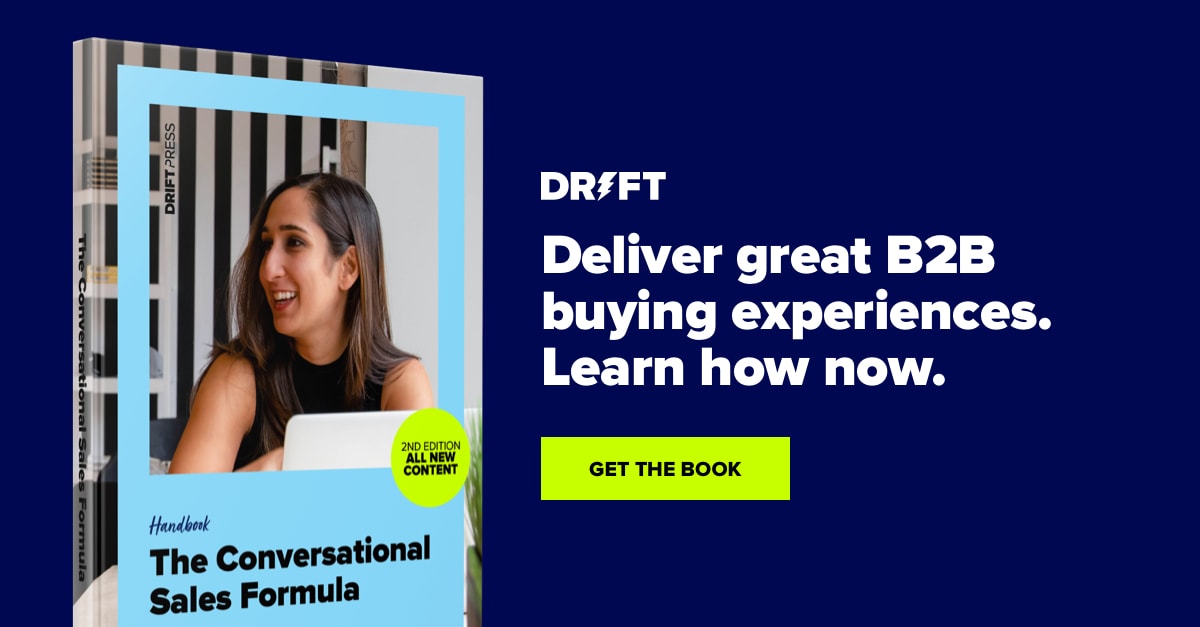“If we could jump on an airplane tonight and go somewhere, where are we going and why?”
Do I have your attention?
If I were a contestant on The Bachelorette, this would be my icebreaker. It’s a question that is engaging and piques interest. That’s the best way to start any conversation, whether you’re trying to find the love of your life…or close a deal.
Full disclosure: I’ve never watched The Bachelorette (or The Bachelor, for that matter). But I have closed a lot of deals, and the principle is the same. It’s about making connections through authentic conversations.
Today’s B2B buyers want a fast and frictionless buying experience personalized to them. For your sales team to succeed in netting new buyers, you need a strategy that seamlessly turns site visitors into booked meetings, meetings into opportunities, and opportunities into customers.
Here are four high-impact sales plays that will make that happen.
I originally spoke about these sales tactics on a Drift webinar. If you want to watch the full presentation, click here. Otherwise, keep reading for all the insights 💡
It Takes Pre-Sales Work to Plow Through Roadblocks
Before we get into the plays themselves, I want to highlight something that often gets forgotten: the pre-sales work that helps streamline the sales cycle. Before you start a sales conversation, ask yourself, “What is my sales mindset?”
With COVID-19, digital has become the new normal. Since 2020, the expectation for a quick, personalized buying experience has grown by 26%.
As a seller, your job is no longer to sell. It is to make it easy to buy. Instead of pushing the sale, you should be helping buyers make the best decision for them — so they can buy from you on their own terms. That is how you will drive revenue in the new era of sales.
To help your sales team become better advisors for buyers, help them focus on the big picture. Here are three things you can do:
- Structure your team for success. If you ask a salesperson to do everything at once, they’re going to be pulled in too many directions. Sort your team by funnel stage, splitting responsibilities between prospecting, closing, and enabling customers.
- Prioritize target accounts and daily schedules. Who are the target accounts you really want to go after? Even if you only have a few customers, figure out what separates the successful buyers from those that churn. Then, carve out some time in your day to focus on those accounts. You won’t find success overnight but, a few months down the road, you’ll be amazed by how much your business has grown.
- Create a strong partnership between sales development reps (SDRs) and account executives. In the long run, this is paramount to any successful sales organization. Your SDRs are your future sellers, so fostering this relationship ensures your SDRs are getting the best training possible.
4 Sales Plays to Drive Better Conversations
Even when it comes to specific sales plays, remember: the seller’s job is to help buyers buy. All of the plays I will introduce focus on having more relevant conversations with target buyers.
As a guide for these conversations, we developed the Conversational Framework for Sales 👇
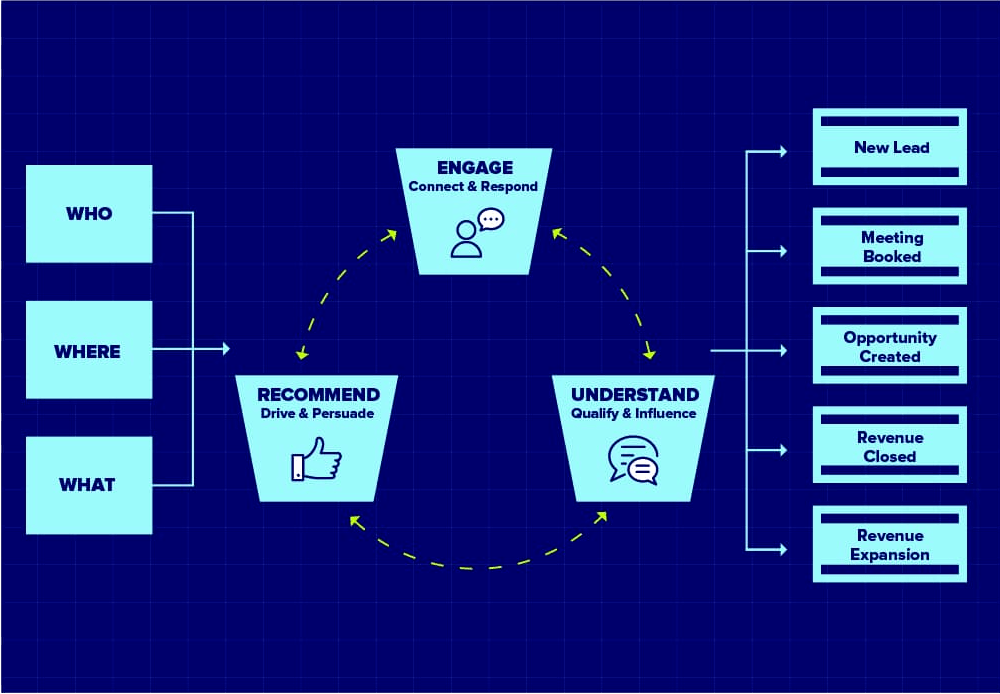
Every day, hundreds of different people come to your website — customers, buyers, partners, potential employees, etc. How can you cater to all their needs in real time while picking out the visitors that count? You need to:
- Engage website visitors with a personalized, relevant conversation starter.
- Understand who they are, what they’re looking for, where they are in the buyer’s journey, and how you can solve their problem.
- Recommend the next best step for them…because no two buyers are the same.
And this doesn’t end at one conversation. Maybe your site visitor becomes a new lead, which is great. But with the full digital experience, you can sign up buyers for events, book meetings, answer bottom-of-the-funnel questions, and even close the deal.
Let’s look at how the Conversational Framework works throughout the buyer’s journey in the following four plays.
Play #1: New Buyer Engagement
When an unknown buyer is on your website, the goal is to learn more about who they are and what they need.
For top-of-the-funnel buyers, you want to have a give-get scenario. You’re not going to start by asking, “Hey, do you want to talk to a salesperson?” Instead, you want to give the buyer what they need. You want to build trust.
In this example, a chatbot has already delivered content by requesting an email address. This means the SDR doesn’t have to start with a completely blank slate.
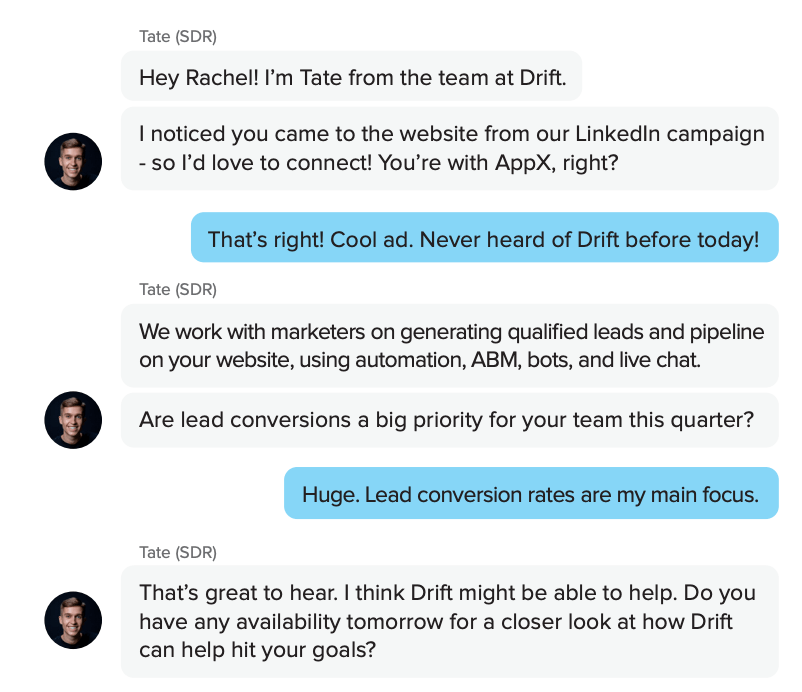
Here is a breakdown of this play:
- Engage: Start with a personalized introduction: calling the visitor by name, referring to the company, and drawing information from campaign analytics.
- Understand: Identify the buyer’s pain point and articulate value in response.
- Recommend: Suggest a meeting while the buyer’s intent is highest.
But not every person who comes to your website is going to convert. That’s why it’s important to get that email address.
If the buyer abandons chat, send an automated follow-up email or (for a more human touch) a personalized video. And, if the buyer chooses not to book a meeting, share relevant resources and add them to a nurture campaign.
In either case, don’t rush the process. Focus on educating the buyer and being as helpful as you can — because how you sell is more important than what you’re selling.
Play #2: Real-Time Connection
There’s nothing like a real-time connection to accelerate deals. Especially when the person on the other end is a buyer that fits your ideal customer profile (ICP).
When someone lands on your website, you have 10 seconds to communicate your value proposition before they get frustrated or distracted. It’s useful to have a chatbot greet visitors automatically, especially when your sales reps aren’t available. But, with your ICP buyers, the real value comes from breaking the bot flow.
The conversation starts when the sales team is notified that the buyer is on the website. Then, a sales rep can switch places with the bot and move towards a Zoom or phone call.
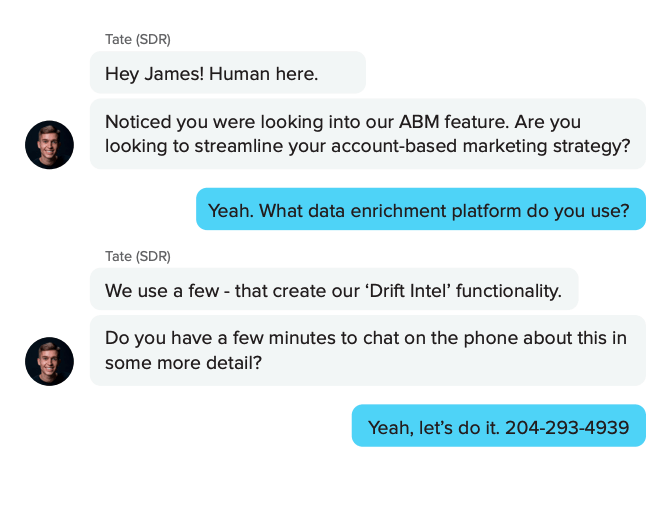
Here is a breakdown of this play:
- Engage: Jump into the conversation quickly and ask a question relevant to the webpage the buyer is on.
- Understand: Identify the buyer’s interest in a specific solution.
- Recommend: Start a phone call straight from chat.
Since this is an ideal customer, you want to keep the ball rolling after that first conversation. Here, the best thing to do is suggest a demo.
If the buyer says they aren’t ready for a demo, enroll them in an outreach sequence so you stay at the top of their mind. So that, when they are ready, the buyer will remember the sales rep they spoke to and can get right back to them.
If the buyer is ready for a demo, Drift can make your scheduling hassle-free. With Drift, you can drop your calendar in the body of an email so the buyer can easily pick a time when they are available. No back-and-forth required. (Plus, email is a great place to do your pre-demo pitch.)
Play #3: Target Account Outreach
Being able to identify a visitor who fits your ICP is a game-changer. What’s even better is being able to pick out your target accounts from a sea of site visitors.
With account-based marketing (ABM), your sales team goes after specific accounts that are a good fit for your product. One way to drive an ABM approach is to alert the assigned sales rep when a target account is on the website. Then, the rep can easily start a chat with a VIP buyer.
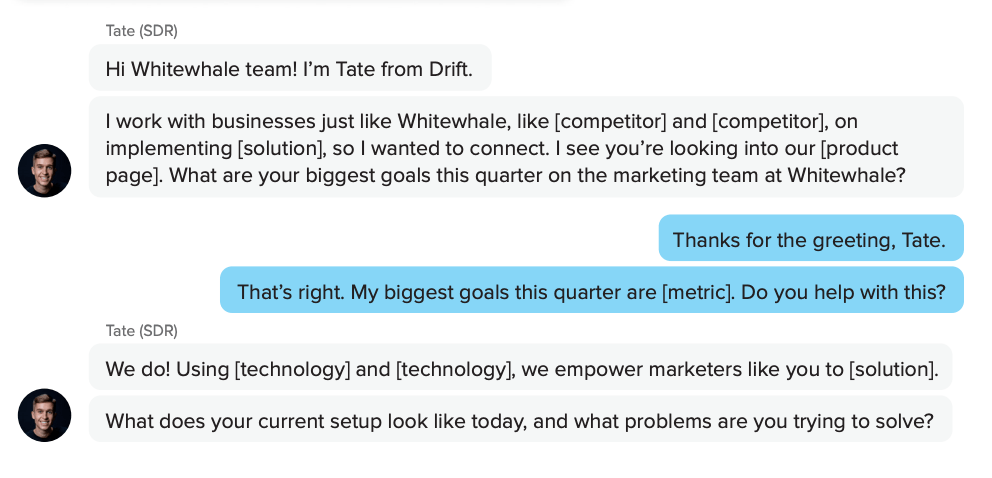
Here is a breakdown of this play:
- Engage: Address the buyer by company name, provide industry-specific context, and ask questions based on the webpage they are looking at.
- Understand: Identify the buyer’s goals and articulate value in response.
- Recommend: Continue asking questions to guide the buyer to the next step.
If you lead the conversation with context and value (instead of a sales pitch), you’re going to get a response from buyers. And that’s the lever you need to better understand your target accounts and eventually book a sales meeting.
Here’s a variation on the play via email outreach:
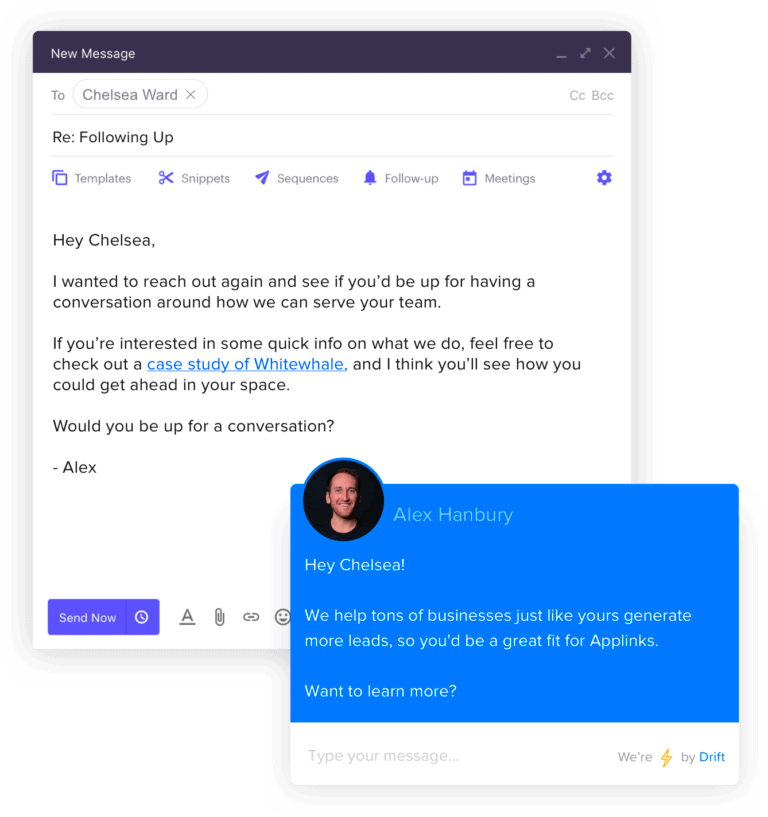
When it comes to executing ABM plays like this, it’s all about getting prospects back to the website. Your website is your digital storefront, so don’t worry too much about getting a reply. Just focus on delivering value and then connect with your target account in real time to help them take the next step in the buyer’s journey.
Play #4: AI Re-Engage Outreach
So far, we’ve mostly focused on human-to-human engagement. But what if a sales rep isn’t available?
This is where AI really makes a difference. AI chatbots are available to chat with buyers 24/7, 365 days a year while retaining the personalized experience that buyers crave.
For example, if your sales reps are offline and a known buyer comes to your website, the AI chatbot can greet them and book a meeting with their assigned rep.
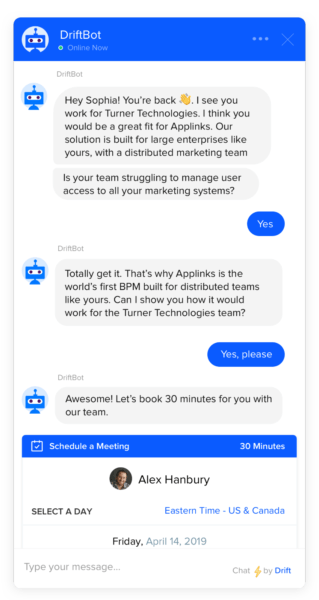
Here is a breakdown of this play:
- Engage: Instantly greet the buyer and send them a message that acknowledges their brand.
- Understand: Identify the buyer’s pain point and articulate value.
- Recommend: Suggest a meeting and drop a calendar in chat.
With AI chatbots in place, it doesn’t matter whether the buyer is browsing your website at 11:00 p.m. on a Saturday or during a holiday. It’s still as if there is a human on the other side of the screen who knows the buyer and understands the problems they need to solve.
Even if the chatbot isn’t successful in booking a meeting, your sales reps can always follow up with the buyer once they’ve logged back on.
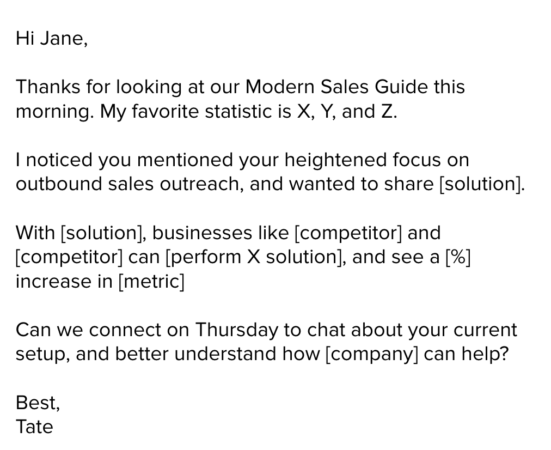
Here is a breakdown of this play:
- Engage: Start the email by acknowledging the buyer’s conversation with the chatbot.
- Understand: Recite details from the conversation and provide a more detailed explanation.
- Recommend: Ask to book a future meeting.
While AI chatbots are great for catching traffic at odd hours, a personalized note goes a long way. Remember, you want to keep the conversation rolling and drive buyers back to your website so you can interact with them in real time.
Accelerate Revenue with a Conversational Buying Experience
To create the buying experience that B2B buyers want, you have to think beyond live chat, emails, or AI. At the end of the day, conversations are what will drive revenue and close deals.
So, my advice is to take our Conversational Framework to heart and offer your buyers an authentic and personalized conversational experience — where the goal is to help buyers find the right solution for them.





